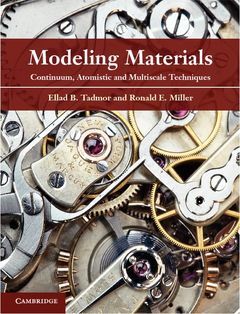Description
Modeling Materials
Continuum, Atomistic and Multiscale Techniques
Authors: Tadmor Ellad B., Miller Ronald E.
Explains many key theoretical ideas behind multiscale modeling for graduate students and researchers in physics, materials science, chemistry and engineering.
Language: English
Subject for Modeling Materials:
Approximative price 87.11 €
In Print (Delivery period: 14 days).
Add to cart
Publication date: 11-2011
786 p. · 19.5x25.3 cm · Hardback
786 p. · 19.5x25.3 cm · Hardback
Description
/li>Contents
/li>Biography
/li>
Material properties emerge from phenomena on scales ranging from Angstroms to millimeters, and only a multiscale treatment can provide a complete understanding. Materials researchers must therefore understand fundamental concepts and techniques from different fields, and these are presented in a comprehensive and integrated fashion for the first time in this book. Incorporating continuum mechanics, quantum mechanics, statistical mechanics, atomistic simulations and multiscale techniques, the book explains many of the key theoretical ideas behind multiscale modeling. Classical topics are blended with new techniques to demonstrate the connections between different fields and highlight current research trends. Example applications drawn from modern research on the thermo-mechanical properties of crystalline solids are used as a unifying focus throughout the text. Together with its companion book, Continuum Mechanics and Thermodynamics (Cambridge University Press, 2011), this work presents the complete fundamentals of materials modeling for graduate students and researchers in physics, materials science, chemistry and engineering.
1. Introduction; Part I. Continuum Mechanics and Thermodynamics: 2. Essential continuum mechanics and thermodynamics; Part II. Atomistics: 3. Lattices and crystal structures; 4. Quantum mechanics of materials; 5. Empirical atomistic models of materials; 6. Molecular statics; Part III. Atomistic Foundations of Continuum Concepts: 7. Classical equilibrium statistical mechanics; 8. Microscopic expressions for continuum fields; 9. Molecular dynamics; Part IV. Multiscale Methods: 10. What is multiscale modeling?; 11. Atomistic constitutive relations for multilattice crystals; 12. Atomistic/continuum coupling: static methods; 13. Atomistic/continuum coupling: finite temperature and dynamics; Appendix; References; Index.
Ellad B. Tadmor is a Professor of Aerospace Engineering and Mechanics at the University of Minnesota. He received his BSc and MSc in Mechanical Engineering from the Technion - Israel Institute of Technology in 1987 and 1991, and his PhD from Brown University in 1996. His research focuses on the development of multiscale theories and computational methods for predicting the behavior of materials directly from the interactions of the atoms making up the material. He has published over 40 papers in this area and two textbooks (see http://modelingmaterials.org for information on the books). Professor Tadmor is the Director of the Knowledgebase of Interatomic Models project (https://openkim.org) which is tasked with developing standards for atomistic simulations and improving transferability of interatomic potentials. He has been a Postdoctoral Research Fellow at Harvard University, Associate Professor at the Technion (Israel), and Erasmus Mundus Scholar at the Ecole Normale Superieure in Lyon (France). He received the MRS Graduate Student Award in 1995 for his work on developing the quasicontinuum method, one of the leading multiscale methods, and has received numerous awards for excellence in teaching, including the Salomon Simon Mani Award in 2001. Professor Tadmor is on the editorial board of the Journal of Elasticity.
Ronald E. Miller is Professor of Mechanical and Aerospace Engineering at Carleton University. He has worked in the area of multiscale materials modeling for over 15 years and has published more than 40 scientific articles in the area.
Ronald E. Miller is Professor of Mechanical and Aerospace Engineering at Carleton University. He has worked in the area of multiscale materials modeling for over 15 years and has published more than 40 scientific articles in the area.
© 2024 LAVOISIER S.A.S.




